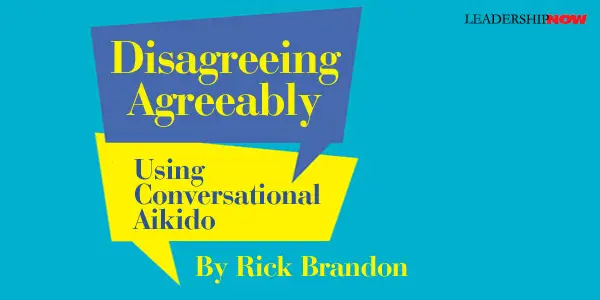 |
 |
05.06.22

Disagreeing Agreeably: Using Conversational Aikido
YOUR boss tells you to implement a new idea or policy that you believe will cause problems (because it’s a boneheaded idea!). You’d be out of integrity not to raise your concerns or tactfully disagree. Still, you don’t want to commit a career-limiting move. Or, you’re comfortable with the overall idea, but you want to foster deeper thinking about potential obstacles, and oh, yeah ... you want to live to talk about it! You’ll Disagree Agreeably by using the Conversational Aikido Technique with managers, associates, clients, vendors, friends, family (especially kids), and others in order to:
Aikido Philosophy. The Eastern martial art of aikido is about harmony, not conflict, and equates well to Disagreeing Agreeably. Western boxing involves overpowering a foe—force against force. Aikido isn’t about striking, overpowering, or forcing an opponent to comply. It entails moving with and aligning with the other’s energy to remain in control. Conversational Aikido involves understanding their viewpoint and finding its merit before expressing your differing point of view. Using Political Savvy. Conversational Aikido is interpersonally savvy and politically savvy. When power, politics, and ego are involved, this tool helps you to fly under the radar of a superior’s “hyperactive ego gland.” Your well-intentioned feedback may be interpreted by ego-trippers as unwarranted criticism or an implied threat. Politically naïve people put their foot in their mouth so much they contract Athlete’s Tongue. They could floss with shoelaces! The Conversational Aikido Technique prevents you from wounding the king or queen. The king or queen is still alive. Your head may get chopped off! Don’t let your intellectual “rightness” or subject matter expertise lure you into criticizing an idea in an overly zealous way, even if the egotist doesn’t possess positional power. Being in someone’s doghouse is unwise regardless of their status. The Conversational Aikido Technique: Step-by-Step Influence adeptness requires awareness of the impact of your behavior. You already know that direct but respectful wording and tone must supplant inflammatory (Aggressive) language or weak (Passive) language. Let’s plug Assertive Speaking, Active Listening, and the Straight Talk Mindset into the steps of the Conversational Aikido Technique for Disagreeing Agreeably:
1. Listen Non Judgmentally and Empathically to the Idea. Focus your body in order to pay empathic, nonjudgmental attention to the person’s idea or request, regardless of what you’re thinking. Paraphrase thoughts and feelings to capture the idea’s essence, rationale, and emotions behind it. This demonstrates respect for the person, proves that you’ve understood their idea, and conveys that you accept its validity for that person. You’re absorbing the idea instead of prematurely reacting, evaluating, or dismissing it. This is akin to aikido’s aligning philosophy, as is the next step. 2. Generously State the Merits of the Idea. Before expressing negative reactions, first show that you see the pluses of the idea or proposed action. Genuinely say everything you like about the idea, and not just in a token way. Really lean into this step with multiple, specific, and sincere, positive comments about the idea’s redeeming qualities and benefits. Like Mary Poppins sings in the movie, “A spoonful of sugar helps the medicine go down.” You’re helping the person consider their idea’s downsides by first being in harmony with its upsides (acknowledging). This “spoonful of sugar” does NOT mean you are BS-ing or sugar-coating your viewpoint about the idea’s cons or drawbacks. Most ideas have some merit, even if it’s just the passion that the person has for it or the energy they invested into developing it. If you can’t find anything positive to say, can you spell r-i-g-i-d? Aren’t you being a crap-detector? Show good faith by digging deeper to find some aspect of the person’s idea that you respect. It’ll pave the way for what comes next—your concerns or disagreement. Lead-in phrases for this merits step include: “What I like about your idea is ... I can appreciate ... You’ve done your homework ... What’s admirable is how you ... The upsides are clear, like ... I support your goal of ... Some merits I see are ... We’re really aligned on ...” 3. Tactfully Surface Your Concerns. You’ve earned the right to candidly share the idea’s variables they haven’t considered or missing pieces. You’ve generously shared the pros, so don’t be shy about voicing the cons. This step’s lead-in phrases include: “Let’s also consider the possibility that . . . An issue might be ... One concern is ... A major challenge could be ... I’m not as confident as you since ... How will we respond to ... A downside I see is ...” When bridging from acknowledging the idea’s positives to voicing reservations, steer clear of the word but or its cousins, however and nevertheless. They erase everything you said before them. The person will only hear the “but,” not the merits you’ve cited. You know what I mean if a romantic interest has ever said to you, “I really like you as a friend, but I’m not interested in dating you.” Ugh. “But” risks your “likes” about an idea coming across as merely going through the motions. 4. Give Your Conclusion. You’ve conveyed both sides of the coin—the idea’s pros (merits) and cons (concerns)—acknowledging that they can stand side by side in the universe. Now, give your bottom-line conclusion, which might be to problem-solve around your concerns and move forward, to withhold support until later, or to graciously decline supporting the idea. You still can convey respect for the person. You’re not rejecting them, just their idea.  
Posted by Michael McKinney at 07:09 AM
|
BUILD YOUR KNOWLEDGE
 

How to Do Your Start-Up Right STRAIGHT TALK FOR START-UPS 
Grow Your Leadership Skills NEW AND UPCOMING LEADERSHIP BOOKS 
Leadership Minute BITE-SIZE CONCEPTS YOU CAN CHEW ON 
Classic Leadership Books BOOKS TO READ BEFORE YOU LEAD |